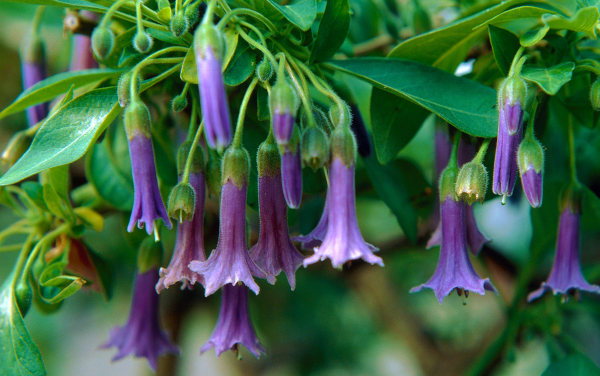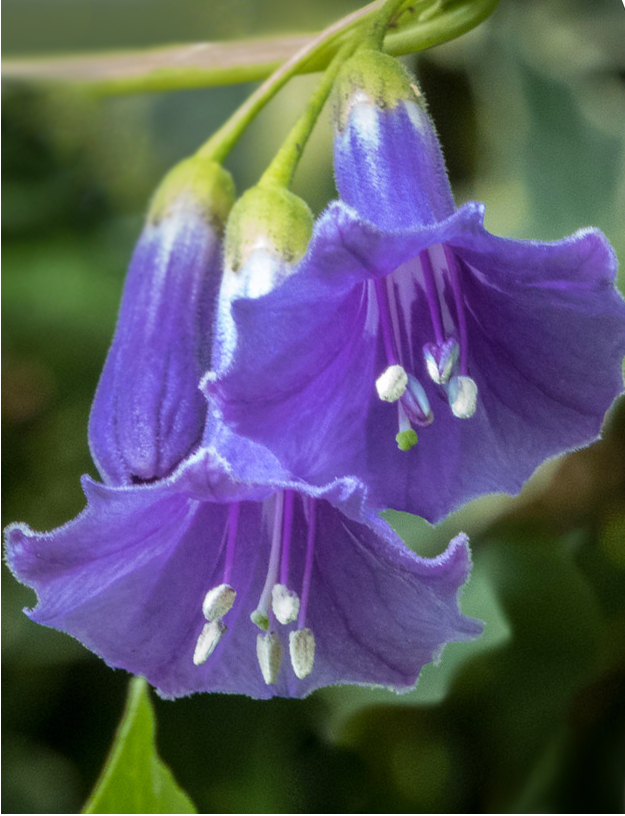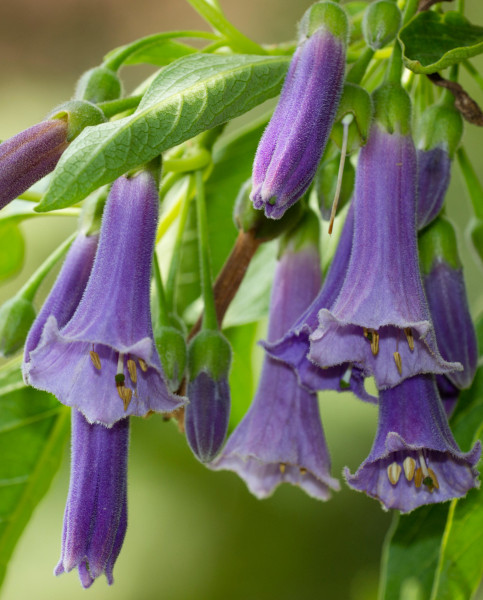How to grow Acnistus

Acnistus is one of those plants which has long since baffled botanists, having been assigned to no less than 11 different genera since becoming known to science. These days, you’ll find it referred to either as acnistus or iochroma. Whatever the name, the plant remains the same – a half-hardy shrub or small tree from Central and South America, grown for its clusters of funnel-shaped, highly fragrant flowers. The foliage tends to be evergreen when grown indoors, becoming deciduous outdoors.
Key Information
Soil pH
Position
Hardiness


Where to plant Acnistus
If you live in a coastal or city centre location where temperatures remain mild, your acnistus/ iochroma can be planted outside from late spring onwards. If your plant has arrived before this, keep it in a bright, protected environment such as a conservatory, greenhouse, or sunny windowsill or porch. For best results, you’ll need to gradually harden your acnistus/ iochroma off before getting it in the ground, which means acclimatising it to the conditions outside over the course of a week or so:
- First few days: move outside, just during the day at first
- Next few days: leave out all the time, with a fleece covering at night
- Final few days: leave out completely uncovered
Give your acnistus/ iochroma the sunniest, most protected spot you have to offer. Against a warm, south-facing wall is ideal, or in a sunny, sheltered border.
For frost-prone areas (i.e., the majority of the UK), acnistus/ iochroma is best grown as a conservatory plant. Choose a spot in indirect light, which may be next to a sunny window with a sheer curtain or shade netting attached, or set back in the room by a couple of metres.
Those grown in containers can be moved outside during the warmer months, i.e., from May-June to September-October. Not only does this mean they add an exotic feel to patios and terraces, but, like many indoor plants, time spent outside also benefits their health. Go for a sunny, sheltered location out of cold, drying winds.
How to plant Acnistus
- For planting in the garden, dig the soil area removing any large stones and weeds and breaking up any lumps. Mix in some organic matter such as manure or garden compost. Rake level and firm with your heels. Rake level again.
- Water plants well and allow to drain before planting.
- A good tip is to dig a hole twice the size of the root-ball. Fill with water and allow to drain before placing in the plant.
- Place the plant in the hole, ensuring the top of the root ball sits level with the surface of the soil. Too low and the plant may rot, too high and the roots can dry out.
- Backfill with soil and firm in gently with your foot.
- Soak well with water.
- Mulch around the base with well-rotted organic matter.
- For planting in containers, first choose an appropriately sized pot. The best practice is to start just a few centimetres larger than the rootball and increase in size every year or two. Always ensure there are plenty of drainage holes in the bottom.
- If you are using a large or heavy pot, it can be a good idea to fill and plant it in situ to save yourself the trouble of moving once full.
- Use a good quality potting compost with plenty of horticultural grit mixed in, and, if not already present in the compost (check the description on the bag) some slow-release fertiliser granules.
- Start by partially filling the pot with compost; enough so that when placed on it the upper surface of the root ball is about 3cm lower than the top of the pot.
- Infill all the space surrounding the root ball with compost, firming down with your fingers then adding a little more so the plant is held tight.
- Pick up the container and lightly tap on the potting bench or ground a few times to help further settle the compost around the plant.
- Soak well with water.
- A mulch with horticultural grit will look attractive and help to prevent a ‘cap’ or crust forming on the top of the compost (something container plants can suffer due to the artificial nature of their watering).

How to care for Acnistus
Pinch out young plants to encourage bushiness. Simply remove the growing tip to a bud lower down using clean, sharp secateurs. Do this in spring.
From then on, acnistus/ iochroma falls into the RHS pruning group 9, which means little or no pruning is required other than a light tidy in mid to late spring. Simply remove any dead, diseased, damaged, or badly placed growth.
If you need to restrict the size, prune back to healthy, outward facing buds in late winter.
Watering
Outside, acnistus/ iochroma should be regularly watered during its first growing season in the ground. After this, it should need watering only in hot, dry weather. Aim to water well and occasionally rather than little or often, as this encourages the formation of a deep, healthy root system. Allowing the top few centimetres of soil to dry out between soakings is a good rule of thumb; to check, wiggle your finger down into the soil until you hit dampness.
Container-grown acnistus/ iochroma have less access to moisture (particularly when grown inside) so need regularly watering throughout every growing season. From March to September, give a good soaking whenever the top few centimetres of compost have dried out (use the finger wiggle technique above to check). Scale back dramatically in winter – just enough to keep the compost from drying out completely.
Feeding
On healthy, fertile soil, an annual mulch of well-rotted organic matter (i.e., a layer of manure or garden compost applied to the soil around the plant) should provide sufficient nutrients for your outdoor-grown acnistus/ iochroma. This has the added benefit of suppressing weeds and locking in moisture and is best done in autumn or spring.
If your plant looks in need of an extra boost or you garden on poor soil, applying a general purpose granular feed to the surface of the soil and lightly working in (known as a ‘top dress’) can reap benefits. Aim to do this in spring.
Container-grown acnistus/ iochroma rely more on the gardener for nutrition. Get off to a flying start by making sure you use a good quality compost, then throughout the growing season (March to September) apply a balanced liquid feed every month. A top dress is also advisable each spring. Simply scrape off the top 5cm of compost and replace with fresh compost containing a general-purpose granular feed. Remember also to repot your plant every few years, increasing the pot size by around 5-10cm each time until it reaches full size.
Cold Protection
Acnistus/ iochroma is half-hardy, meaning it is unable to withstand a UK winter outside in all but the mildest of microclimates. In most cases it is advisable to overwinter in a covered environment such as a conservatory or greenhouse. If this is unheated, a covering of fleece is also recommended.
Those who garden in a location where temperatures remain mild can grow acnistus/ iochroma outside in a warm, sheltered spot, though should be braced for the occasional winter loss. We advise taking cuttings as an insurance policy, as below in ‘How to propagate acnistus/ iochroma’.
Pests and Diseases
Outdoors, acnistus/ iochroma tends to be problem-free, though in conservatories the usual issues of spider mite and aphid can crop up. Keeping plants as healthy as possible is the key to warding off problems, and by this we mean proper ventilation, adequately spaced plants (for good air flow), keeping everything well-watered and fed, and repotting into larger containers when necessary. Thoroughly cleaning the indoor environment every winter can also help to remove overwintering populations of pests.
Where infestations do take hold, try introducing biological controls (often sachets or tubes containing miniscule natural predators), or in the worst cases, remove the affected plant/s altogether.
How to propagate Acnistus
Acnistus/ iochroma can be propagated by cuttings taken in summer.
- Find non-flowering shoots 5-10cm long and snip off the plant.
- Put them in a plastic bag straight away to prevent drying out.
- Fill a container with a compost mix which is at least 50% perlite (or if you prefer, as we do, 100% perlite).
- Remove the lowest third of leaves. If the remaining leaves are large, cut them in half (to reduce water lost through transpiration).
- Insert the cuttings into the compost and water lightly. Several cuttings can be put in the same container if there is enough space to do this without them touching.
- Place in a propagating unit with bottom heat if you have one or covered with a plastic bag on a windowsill if not (out of direct sunlight).
- Keep the cuttings misted and occasionally watered until they root. You will know this has happened when roots emerge out of the bottom of the container.
- Gently remove rooted cuttings and pot them into individual pots. Grow on in a conservatory or greenhouse they are big enough to be planted into a permanent container or the ground.
* Many plants carry Plant Breeders Rights and cannot be propagated for commercial purposes.
Common Acnistus questions
- Is acnistus/ iochroma poisonous?
This plant belongs to the nightshade family and can be toxic when ingested. Take care where children or pets are present. - Can acnistus/ iochroma be propagated via seed?
It can (sown at 13-18°C in spring), although in our climate plants are unlikely to produce ripened seed. - Where can I see a good example of this plant?
Acnistus/ iochroma has naturalised throughout Ventnor Botanic Garden on the Isle of Wight, where an exceptionally mild microclimate allows it to thrive.




